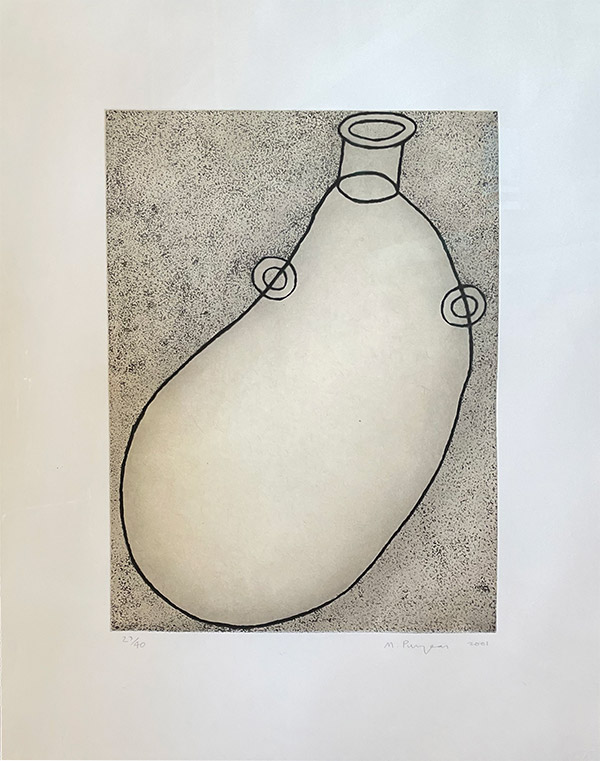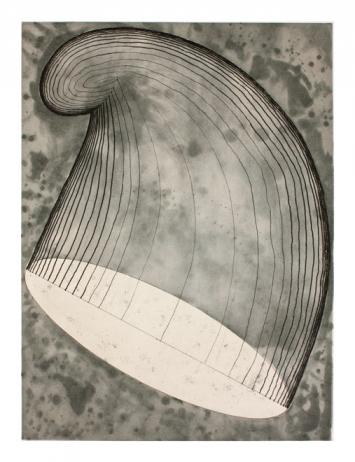|
Recent Etchings
September 5 - November 1, 2014
Prices are subject to change as editions sell out

JUG, 2002
Color spitbite aquatint, etching, drypoint, chine collé
35 x 28 inches
Edition of 40
$15,000
2_sm.jpg)
FROM ABOVE (BEIJING), 2013
Color aquatint etching
29 x 34 inches
Edition of 40
$8,600

PHRYGIAN, 2012
Color aquatint etching
35 x 28 inches
Edition of 50
$15,000
In his second project with Paulson Press, Martin Puryear translated his formidable talent of shaping pliable materials, such as wood and wire mesh coated with tar, to the process of printmaking. The results are remarkably compelling images conveyed with dignity and artful eloquence. Cited by Robert Hughes as "America's Best" of sculptors, Puryear's sculpture is distinguished by its inventive form and consummate craftsmanship. His images can best be described as organic abstractions, semblances of pared down forms that refer to the natural world.
Three Holes embodies the simplicity of form and evocative power characteristic of Puryear's sculpture and is reminiscent of his three dimensional pieces constructed from wire mesh and tar. The image suggests an archetypal monolith, regal in its presence. Densely drawn black interlocking lines originate from three small holes to create an organic spherical form. The image sits on the edge of the picture plane and is set against an atmospheric background in sepia tones. From a distance, the shape appears almost solid but on closer view the meshed lines reveal a vessel-like container. Puryear frequently explores the theme of the vessel in his work. Vessels hold or enclose space, suggesting protection, survival, fullness or emptiness, sanctuary, or captivity. In this particular image, the opposition between the work's seemingly opaque exterior and its obscured but transparent interior reinforces its subtle but pervasive sense of mystery. Powerful and elegant, Profile is a solid, black organic shape with rounded contours. Dense, intersecting black lines were first drawn in soft ground and then layered over with drypoint to create the extreme darkness of this form.
Toward the bottom of the shape, an ellipse exposes the soft ground layer, producing a contrast between the opaque and the transparent. Soft silver gray elliptical shapes printed beneath the Gampi float on a diaphanous background. Combined with tactile impressions and delicate marks, the background field of this print is infused with another layer of subtly. In contrast to the solidity of Profile, Puryear created a refined, simple curved line form that lies somewhere between the figurative and the abstract in Untitled II. Drawn in a fine black drypoint line with spit bite aquatint added to create a textured background, this shape is also vessel-like, but is not a clear representation of an actual receptacle.
Like his sculpture, Puryear's etched forms are filled with the possibility of meaning; they are not only objects of compelling beauty but are seductive sites of discovery and revelation. A simple, linear shape characterizes Untitled III (State 1) and Untitled III (State 2). In these two prints, Puryear worked on one plate to create two separate but related images. After completing Untitled III (State 1), he returned to the image in State 2 and added darkened stippled marks that delineate the outer rim and bottom section of the shape from the overall body of the form. The woven or basketlike construction of Untitled I recalls a number of Puryear's sculptural works in which he used latticed structures and basketry techniques. In this small work in sharply contrasting black and white, Puryear drew delicate interlacing lines with a permanent black marker that later acted as a resist when submerged in the acid bath. Where the lines were drawn, only detailed white lines remain to create a vessel-like form. The lines emerge out of and return to three primary holes, again suggesting notions of inside and outside space, containment and freedom and the complex dynamic between the interior and the exterior.
Martin Puryear graduated from Catholic University of America in Washington D.C., and then joined the Peace Corps, traveling to Sierra Leone. He also studied art at the Swedish Royal Academy of Art, and attained his MFA in sculpture from Yale University. Puryear has had an illustrious career and has exhibited at numerous museums and galleries across the United States and internationally. His accomplishments are far too lengthy to list here, but some of the highlights of his career include a mid-career retrospective organized by the Art Institute of Chicago, which traveled to the Hirshhorn in Washington, DC, the Museum of Contemporary Art, Los Angeles, California, and the Philadelphia Museum of Art, Pennsylvania. He has created many public installations including for the City of Chicago, Washington D.C., New York, as well as for private collections including the John P. Getty Museum, Los Angeles. He exhibits at McKee Gallery in New York, Donald Young Gallery in Chicago and Margo Leavin Gallery in Los Angeles. He currently lives and works in upstate New York
- Text courtesy of Paulson Press
|